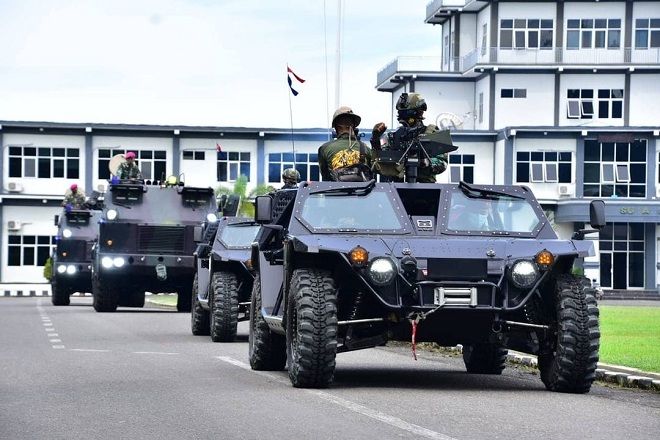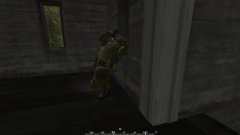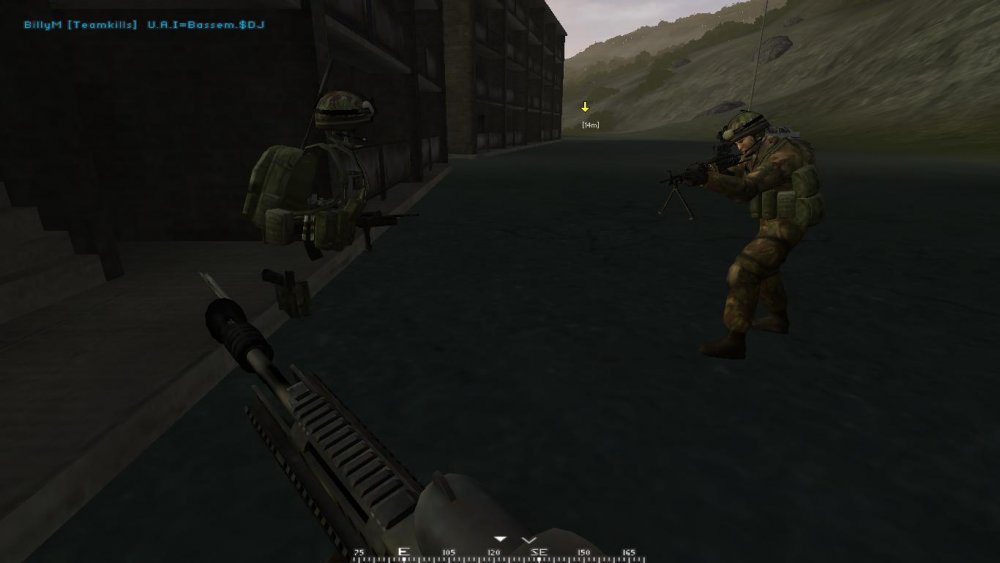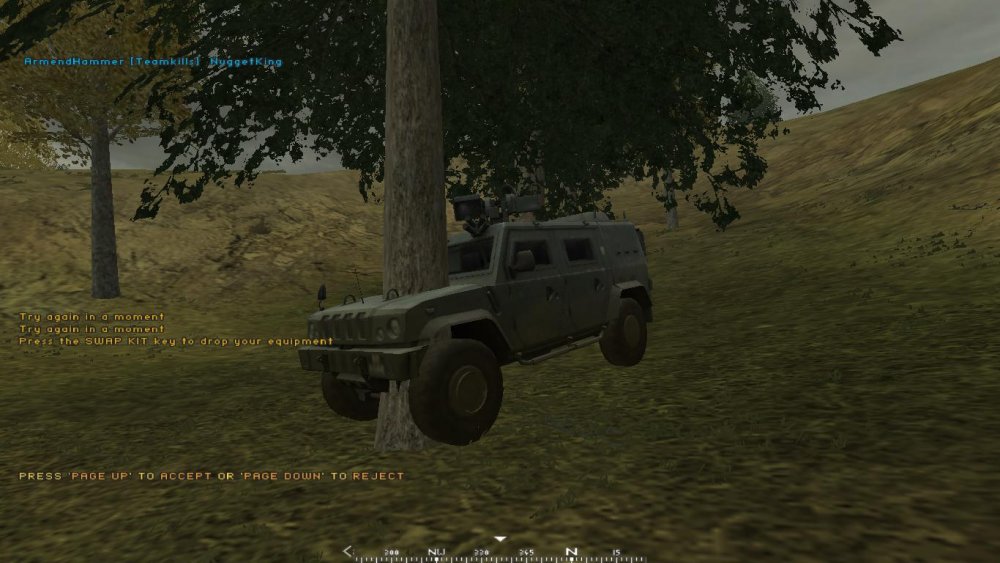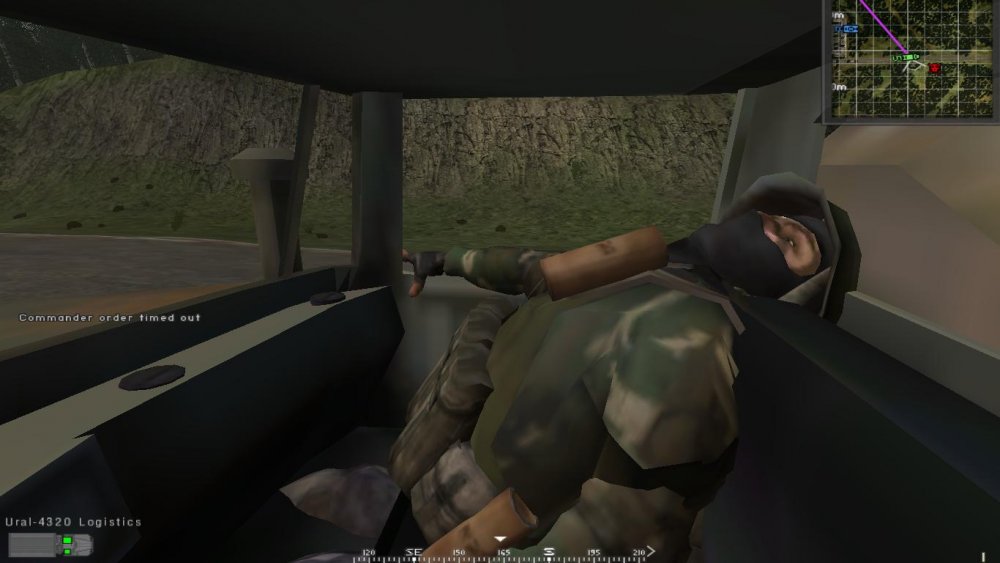-
Posts
498 -
Joined
-
Last visited
Content Type
Profiles
Forums
Events
Downloads
Gallery
Articles
AVCS Bug Reports (automated)
AVCS Bug Reports (manual)
VG Wiki
Blogs
Store
Everything posted by =VG= Inch
-
I'm totally missing them lately, since some of the map rotations has slightly changed, like for example: - Muttrah City (STD or LRG) is seem to be gone from the Default map rotation, and the painful Karbala some times shown up as the first starting map (Definitely need to fix this, coz at some low pops.. server just really dead afterwards if server restarts/crashes) - Almost everyone hates playing Pavlovsk Bay (ALT) as starting map of 1st Custom map rotation and repeated after couple of 3 rounds (Asad Khal, Marlin, Khamisiyah) back to another Pavlovsk Bay (STD), just kinda tiring and BORING for some other players... admins sometimes can be forced to change it to some random maps.. - I haven't seen the 2nd Custom map rotation, which is Khamisiyah as starting map and goes to Vadso City etc., it is also seem to be gone from rotation (Why?) - 3rd Custom map rotation, which is Jabal as starting map, doesn't have the British Campaign (i'll always remember this one supposed to have Shijia STD and Burning STD), instead both of them seems to changed to different maps (if i'm not wrong, from my point of view, was changed to Marlin ALT and Lashkar STD as next map) - Everything seems confusing, after looking again... almost all map rotations (not including the Default map rotations) have their way back to Pavlovsk Bay (STD) every couple 3 or 5 rounds after the first starting map, and goes on to some random/repetitive map almost everyday (Beirut, Karbala, etc.). Admins should think about this again for future - Kashan (ALT, STD or LRG respectively) can be the server "life saver" from dead sometimes, but it is always putted down the last one in option when the server getting low pop - People always wanted Silent Eagle (especially the STD) to make it's comeback, right? Just wanted to ask, is the STD still has some issues lately? Or is it done and ready to play? And here's the list of maps that i completely forgot to put in or set when needed (i had my reasons not playing the map, coz afraid of crashing): - Vadso City (ALT, STD or even LRG) - Saaremaa (ALT, STD) - Nuijamaa (STD) - Dovre (both Dovre STD and Dovre Winter STD) - Op. Archer (INF, STD) - Hades Peak (INF, ALT) - Bijar Canyons (STD) - SPECIAL MENTION - Al-Basrah (INF, ALT, STD) - Assault on Grozny (INF, ALT, STD) - Dragon Fly (INF, STD) - Wanda Shan (STD) - SPECIAL MENTION - Xiangshan (STD) - Black Gold (INF ALT, STD) - SPECIAL MENTION - Sbeneh Outskirts (INF, ALT, STD) - SPECIAL MENTION w/h OPFOR layout - Kozelsk (INF, ALT, STD) - SPECIAL MENTION w/h OPFOR layout - Ramiel (ALT, STD, LRG) - Silent Eagle (INF, ALT and still no for STD) - and many more possiblities like Falklands maps (Goose Green STD, Falklands INF) and fan favorite Nam maps (Charlie, Ia Drang, Hill 488, Tad Sae), but for this kind of map, yet again depends of its population.. Anyways, please remind everyone about these maps that i mention above for alternatives in field, these maps needs some love.. - Inch
-

My Modding Skillz & Tutorials
=VG= Inch commented on =VG= Fastjack's blog entry in Project Reality Coop Insurgency Gamemode
Wish i know more about this thing. Imagining a FV101 Scorpion 90 for British Armed Forces :3 Problem is for the Turret (with Cupola Gunner, 7.62mm MG) and it's 90mm Gun, PR doesn't have the models or even animations for that Is it possible to make this in BF2Editor? Or should make/port the models first bfore going for coding? This above is ones from Indonesian Army - Inch -
Trying the impossible, seems the water was helping you bouncing up there bfore it crashes Anyways, its awesome to keep posting some bloopers around, so anyone would know the Refractor engine physics.. especially like this PR Magic word came so late: "Osuka: Pull up, Ranger. Pull up-!" - Inch
-
*Last night were have played the maps like: mapList.append pavlovsk_bay gpm_coop 32 mapList.append albasrah gpm_coop 32 (No Al Basrah for some reason, looking at the history) mapList.append asad_khal gpm_coop 64 mapList.append operation_marlin gpm_coop 64 mapList.append khamisiyah gpm_coop 64 mapList.append pavlovsk_bay gpm_coop 64 (Changed to Kozelsk STD by me from Mapvote) mapList.append karbala gpm_coop 32 (Default to Wanda Shan STD after Kozelsk STD) mapList.append beirut gpm_coop 64 (Changed to Sbeneh INF by chickenjason from previous next map, Muttrah LRG) Can someone confirm this? Even the maps not changed, im pretty sure the crash not occur when had few players... These maps running smoothly tbh, no issues yesterday... - Inch
-
Please wait for the banning admin to respond- - Inch
-
Vincent strikes again, always love those jokes around - Inch
-
Hey, guys- This is InchPincherToo and you are about to read an article about Rheinmetall 120 mm Gun, which is one of the standard armaments of few Tanks in PR, such as German Krauss-Maffei Leopard series, U.S.A M1 Abrams series and also seems indirectly used to Israeli Merkava series of tanks as well-! This is just quite sick gun indeed, been widely used as main armaments of few tanks around the world and also have long past history within it-! The Rheinmetall 120 mm gun is a smoothbore tank gun designed and produced by the West German Rheinmetall-DeTec AGcompany, developed in response to Soviet advances in armor technology and development of new armored threats. Production began in 1974, with the first version of the gun, known as the L/44 as it was 44 calibers long, used on the German Leopard 2 tank and soon produced under license for the American M1A1 Abrams and other tanks. The American version, the M256, uses a coil spring recoil system instead of a hydraulic system. The 120-millimeter (4.7 in) gun has a length of 5.28 meters (17.3 ft), and the gun system weighs approximately 3,317 kilograms (7,313 lb). By 1990, the L/44 was not considered powerful enough to deal with future Soviet armour, which stimulated an effort by Rheinmetall to develop a better main armament. This first involved a 140-millimeter (5.5 in) tank gun named Neue Panzerkanone 140 ("new tank gun 140"), but later turned into a compromise which led to the development of an advanced 120 mm gun, the L/55, based on the same internal geometry as the L/44 and installed in the same breech and mount. The L/55 is 1.32 meters (4.3 ft) longer, giving increased muzzle velocity to ammunition fired through it. As the L/55 retains the same barrel geometry, it can fire the same ammunition as the L/44. This gun was retrofitted into German and Dutch Leopard 2's, and chosen as the main gun of the Spanish Leopard 2E and the Greek Leopard 2HEL. It was tested on the British Challenger 2 as a potential replacement for its current weapon, the rifled L30120 mm cannon. A variety of ammunition has been developed for use by tanks with guns based on Rheinmetall's original L/44 design. This includes a series of kinetic energy penetrators, such as the American M829 series, and high explosive anti-tank warheads. Recent ammunition includes a range of anti-personnel rounds and demolition munitions. The LAHAT, developed in Israel, is a gun-launched missile which has received interest from Germany and other Leopard 2 users, and is designed to defeat both land armour and combat helicopters. The Israelis also introduced a new anti-personnel munition which limits collateral damage by controlling the fragmentation of the projectile. - Background: Because of concerns about the inability of the 105-millimeter (4.1 in) L7 tank gun then in use across NATO forces to penetrate new Soviet armor, as proved in German tests on four T-62 Soviet tanks captured by Israel following the June 1967 Six Day War, Rheinmetall was paid for the development of a new tank gun, a project started in 1965, as the Bundeswehr felt a more powerful gun was needed for its new tanks. The first instance of a larger Soviet tank gun was witnessed on the chassis of a modified T-55 in 1961. In 1965, the Soviet Union's T-62 made its first public appearance, armed with a 115-millimeter (4.5 in) smoothbore tank gun. The Soviet decision to increase the power of its tank's main armament had come when, in the early 1960s, an Iranian tank commander defected over the Soviet border in a brand-new M60 Patton tank, which was armed with the British Royal Ordnance L7. Despite the introduction of the T-62, in 1969 their T-64 tank was rearmed with a new 125-millimeter (4.9 in) tank gun, while in 1972 Nizhny Tagil began production of the T-72 tank, also armed with the 125-millimeter (4.9 in) gun. For example, at the fighting at Sultan Yakoub, during the 1982 Lebanon War, the Israeli government claimed to have destroyed nine Syrian T-72's with the Merkava main battle tank, armed with an Israeli production version of the American M68 105-millimeter (4.1 in) tank gun (which in turn was based on the British L7). Whether or not true, the Soviets test-fired a number of Israeli M111 Hetz armor-piercing discarding sabot rounds at Kubinka, finding the 105-millimeter (4.1 in) round was able to perforate the T-72's sloped front section plate, but not it's turret armor. In response, the Soviets developed the T-72M1. This led Israel to opt for a 120 mm tank gun during the development process of the Merkava III main battle tank. This case is similar to the American decision to replace the M68 105-millimeter (4.1 in) tank gun with Rheinmetall's 120 mm gun in 1976; the introduction of the T-64A had raised the question within the armor community whether the new ammunition for the existing gun caliber could effectively deal with the new Soviet tank. In 1963, Germany and the United States had already embarked on a joint tank program, known as the MBT-70. The new tank carried a three-man crew, with the driver in the turret, an automatic loader for the main gun, a 20-millimeter (0.79 in) autocannon as secondary armament, an active hydropneumatic suspension and spaced armour on the glacis plate and the front turret. The new tank concept also had improved armament, a 152-millimeter (6.0 in) missile-launching main gun, designed to fire the MGM-51 Shillelagh anti-tank missile. However, the German Army was interested in a tank gun which could fire conventional ammunition. Although there were attempts to modify the 152-millimeter (6.0 in) tank gun to do so, the process proved extremely difficult, and the Germans began development of the future Rheinmetall 120 mm gun instead. In 1967, the German Ministry of Defense decided to re-open a Leopard 1 improvement program, known as the Vergoldeter Leopard ("Gilded Leopard"), later renamed the Keiler ("Wild Boar"). Krauss-Maffei was chosen as the contractor, and two prototypes were developed in 1969 and 1970. This program grew into the Leopard 2; the first prototype of the new tank was delivered in 1972, equipped with a 105-millimeter (4.1 in) smoothbore main gun. Between 1972 and 1975, a total of 17 prototypes were developed. The new 120 mm gun's ten-year development effort, which had begun in 1964, ended in 1974. Ten of the 17 turrets built were equipped with the 105 mm smoothbore gun, and the other seven were equipped with the larger 120 mm gun. Another program aimed to mount the 152-millimeter (6.0 in) missile-gun was also developed in an attempt to save components from the MBT-70, but in 1971 the program was ended for economic reasons. Instead, the Germans opted for Rheinmetall's 120 mm L/44 smoothbore tank gun. - Design Features/Variants: Rheinmetall's L/44 tank gun has a caliber of 120 mm, and a length of 44 calibers (5.28 meters (17.3 ft)). The gun's barrel weighs 1,190 kilograms (2,620 lb), and on the M1 Abrams the gun mount weighs 3,317 kilograms (7,313 lb), while the new barrel (L/55) is 55 calibers long, 1.30 meters (4.3 ft) longer. The bore evacuator and the gun's thermal sleeve, designed to regulate the temperature of the barrel, are made of glass-reinforced plastic, while the barrel has a chrome lining to increase barrel life. Originally the gun had an EFC barrel life of ~1,500 rounds, but with recent advances in propellant technology the average life has increased even further. The gun's recoil mechanism is composed of two hydraulic retarders and a hydropneumatic assembly. Rheinmetall L/44 120mm Production of the German Leopard 2 and the new 120 mm tank gun began in 1979, fulfilling an order for the German Army. Although the American M1 Abrams was originally armed with the M68A1 105 mm gun (a version of the L7), the United States Army had planned to fit the tank with a larger main gun at a later date, and the tank's turret had been designed to accommodate a larger 120 mm gun. The larger gun was integrated into the M1A1 Abrams, with the first vehicle coming off the production line in 1985. The gun, known as the M256, was based on the L/44 tank gun, although manufactured at Watervliet Arsenal and modified to increase the resistance of the barrels to fracture and fatigue. Tanks armed with versions of Rheinmetall's gun produced under licence include Japan's Type 90 and South Korea's K1A1. The gun had made a huge turn in technological history. Rheinmetall L/55 120mm The appearance of new Soviet tanks such as the T-80B during the late 1970s and early 1980s demanded the development of new technologies and weapons to counter the threat posed to Western armor. The T-80B had increased firepower and a new composite ceramic armor. The T-72 also went through a modernization program in an attempt to bring it up to the standards of the T-80B. In 1985 the new T-72B version entered production, with a new laminate armor protection system; its turret armor, designed primarily to defeat anti-tank missiles, surpassed the T-80B's in protection. The German government began the development of the Leopard 3, although this was canceled after the fall of the Soviet Union. On 29 October 1991, the governments of Switzerland, the Netherlands and Germany agreed to cooperate in the development of a modernization program for the Leopard 2. Part of this program included the introduction of a longer 120 mm tank gun, a cheaper alternative to a brand new tank gun, increasing the maximum range of the gun by an estimated 1,500 m (1,600 yd). Although the gun is longer, allowing for a higher 580 MPa (84,122 psi) peak pressure from the propellant, the geometry remains the same, allowing the gun to fire the same ammunition as that fired from the shorter version. The longer barrel allows ammunition to attain higher velocities; for example, with new kinetic energy penetrators ammunition can reach velocities of around 1,800 m/s (5,900 ft/s). The new barrel weighs 1,347 kg (2,970 lb). The longer tank gun has been retrofitted into the Leopard 2, creating a model known as the Leopard 2A6. Both the Spanish Leopard 2E and the Greek Leopard 2HEL, as derivatives of the Leopard 2A6, use the 55 caliber-long tank gun. Rheinmetall 130 mm Gun Rheinmetall introduced a larger 130 mm tank gun at Eurosatory 2016 in June 2016. Development commenced in 2015, financed entirely using internal funding, as a response to the Russian introduction of new generation armored vehicles like the T-14 Armata tank, and the first technical demonstrator (TD) was completed in May 2016. The new 130 mm gun has an L/51 chrome-lined smoothbore barrel with a vertical sliding breech mechanism, increased chamber volume, no muzzle brake, a thermal sleeve, and a muzzle reference system (MRS) enabling it to be bore sighted on a more regular basis without the crew needing to leave the platform. Compared to the 2700 kg 120 mm gun, the 130 mm has a 1,400 kg (3,100 lb) barrel and an all-up weight of 3000 kg including the recoil system. Rheinmetall is developing a new generation APFSDS round featuring a semi-combustible cartridge case, new propellant, and new advanced long rod tungsten penetrator as well as a high-explosive air-bursting munition (HE ABM) based on the 120 mm DM11 HE ABM in parallel with the gun; the cartridges are 30 kg (66 lb) and 1.3 m (4.3 ft) long that, according to the company, with the increase of 8% in caliber results in 50% more kinetic energy over the 120 mm gun. Engineers believe the weapon can only be used with an automatic loader and new turret design. The gun commenced static firing trials at Rheinmetall's proving ground following Eurosatory, while engineers hope to receive a new NATO standard by the end of 2016, although development of the gun and ammunition will likely take 8–10 years. The 130 mm is designed to equip the Main Ground Combat System (MGCS), a joint effort between Germany and France to produce a successor to the Leopard 2 and Leclerc, possibly to be launched between 2025-2030. - Ammunition: A variety of rounds have been developed for Rheinmetall's tank gun. For example, a long line of armor-piercing discarding sabot (APDS) rounds was developed by Rheinmetall. Originally, the Leopard 2 was outfitted with the DM23 kinetic energy penetrator, based on the Israeli M111 Hetz. The DM23 was eventually replaced by the DM33, which was also adopted by Japan, Italy, Netherlands and Switzerland. The DM33 has a three-part aluminum sabot and a two-part tungsten penetrator, and is said to be able to penetrate 560 millimeters (22 in) of steel armor at a range of 2,000 meters (2,200 yd). The DM43 is a further development of this round, co-developed between Germany and France. The introduction of the longer barrel came hand in hand with the introduction of a new kinetic energy penetrator, the DM53. With the projectile including sabot weighing in at 8.35 kilograms with a 38:1 length to diameter ratio and with a muzzle velocity of 1,750 meters per second (5,700 ft/s), the DM53 has an effective engagement range of up to 4,000 meters (4,400 yd). A further development, called the DM63, improved upon the round by introducing a new temperature-independent propellant, which allows the propellant to have a constant pattern of expansion between ambient temperatures inside the gun barrel from −47 °C (−53 °F) to +71 °C (160 °F). The new propellant powders, known as surface-coated double-base (SCDB) propellants, allow the DM63 to be used in many climates with consistent results. The new ammunition has been accepted into service with the Dutch and Swiss, as well as German, armies. The United States developed its own kinetic energy penetrator (KEP) tank round in the form of an Armor-Piercing Fin-Stabilized Discarding-Sabot (APFSDS) round, using a depleted uranium (DU) alloy long-rod penetrator (LRP), designated as the M829, followed by improved versions. An immediate improvement, known as the M829A1, was called the "Silver Bullet" after its good combat performance during the Gulf War against Iraqi T-55's, T-62's and T-72 tanks. The M829 series centers around the depleted uranium penetrator, designed to penetrate enemy armor through kinetic energy and to shatter inside the turret, doing much damage within the tank. In 1998, the United States military introduced the M829A2, which has an improved depleted uranium penetrator and composite sabot petals. In 2002, production began of the ($10,000 per round) M829A3 using a more efficient propellant (RPD-380 stick), a lighter injection-molded sabot, and a longer (800mm) and heavier (10 kg / 22 lb) DU penetrator, which is said to be able to defeat the latest versions of Russian Kontakt-5 explosive reactive armor (ERA). This variant is unofficially referred to by Abrams tank crews as the "super sabot". In response to the M829A3, the Russian army designed Relikt, the most modern Russian ERA, which is claimed to be twice as effective as Kontakt-5. A further improved M829E4 round with a segmented penetrator to defeat Relikt has been under development since 2011 and was to be fielded as the M829A4 in 2015. Both Germany and the United States have developed several other rounds. These include the German DM12 multi-purpose anti-tank projectile (MPAT), based on the technology in a high explosive anti-tank (HEAT) warhead. However, it has been found that the DM12's armor-killing abilities are limited by the lack of blast and fragmentation effects, and that the round is less valuable against lightly armored targets. The United States also has a MPAT type projectile, known as the M830. This was later developed into the M830A1, which allows the M1 Abrams to use the round against helicopters. The M1 Abrams can use the M1028 canister round, which is an anti-personnel/anti-helicopter munition, packed with over 1,000 tungsten balls. The United States Armed Forces accepted a new demolition round, called the M908 Obstacle Defeating Round, based on the M830A1 MPAT, but with the proximity fuse replaced by a hardened nose cap. The cap allows the round to impact and embed itself in concrete, then exploding inside the target and causing more damage. The Israeli Army introduced a new round known as the Laser Homing Anti-Tank (LAHAT) projectile (see on the right). Using a semi-active laser homing guidance method, the LAHAT can be guided by the tank's crew or by teams on the ground, while the missile's trajectory can be selected to either attack from the top (to defeat enemy armor) or direct attack (to engage enemy helicopters). Furthermore, the missile can be fired by both 105-millimeter (4.1 in) and 120 mm tank guns. The LAHAT has been offered as an option for the Leopard 2, and has been marketed by both Israel Military Industries and Rheinmetall to Leopard 2 users. Israeli Merkavas make use of a round known as the APAM, which is an anti-personnel munition designed to release fragmentation at controlled intervals to limit the extent of damage. Fragments are shaped to have enough kinetic energy to penetrate body armor. Poland has introduced a series of projectiles for Rheinmetall's tank gun, including an armor-piercing penetrator target practice round (APFSDS-T-TP), a high-explosive round, and a high-explosive target practice (HE-TP) projectile. The ammunition is manufactured by Zakłady Produkcji Specjalnej Sp. z o.o. - Operators: Due to tank sales, Rheinmetall's L/44 tank gun has been manufactured for other nations. For example, the Leopard 2 armed with the 44 caliber long gun, has been sold to the Netherlands, Switzerland, Sweden, Spain, Austria, Denmark, Finland, and other countries. Egypt had manufactured 700–800 M1A1 Abrams by 2005, and in 2008 requested permission to build another 125 tanks; their M256 main guns (the US version of the L/44) were manufactured by Watervliet Arsenal. The M1A1 has also been exported to Australia, while the M1A2 Abrams has been exported to Saudi Arabia and Kuwait. The American license-built M256 has also been offered by General Dynamics Land Systems as part of the M60-2000 Main Battle Tank which would upgrade older M60 Patton tanks to have capabilities of their M1A1 Abrams at a reduced cost, though the company has not yet found a buyer. The Leopard 2A6 and its longer L/55 main gun have been exported for use by the Canadian Army, and the Netherlands upgraded part of its original fleet of Leopard 2's with the more powerful armament. The British Army has tested Rheinmetall's longer gun, possibly looking to replace the current L30A1 120 mm L/55 rifled main gun on the Challenger 2. Two Challenger 2's were modified to undergo firing trials. Although South Korean K2 Black Panther is equipped with a L/55 main gun and shows similar characteristics as its German counterpart, it is indigenously developed by Agency for Defense Development and World Industries Ace Corporation (WIA), a Korea-based powertrain company affiliated with Hyundai Kia Motors Group. Tank Designer Country Gun Users Leopard 2 Krauss-Maffei Germany Rheinmetall 120 mm L/44 Austria, Canada, Chile, Denmark, Finland, Greece, Indonesia, the Netherlands, Norway, Poland, Portugal, Singapore, Spain, Sweden, Switzerland, Turkey "Obviously not this one above- " M1A1 Abrams General Dynamics Land Systems United States M256 (L/44) Australia, Egypt, Iraq, Kuwait, Saudi Arabia Type 90 Mitsubishi Heavy Industries Japan Rheinmetall 120 mm L/44 K1A1 Hyundai Rotem South Korea KM256 C1 Ariete OTO Melara Italy Rheinmetall 120 mm L/44 Leopard 2A6 Krauss-Maffei Germany Rheinmetall 120 mm L/55 Canada, Finland, Greece, Netherlands, Portugal, Spain Altay (tank) Roketsan, Aselsan, Otokar, Hyundai Rotem, MKEK Turkey Rheinmetall 120 mm L/55 Turkey - Specifications: Type Smoothbore tank gun Place of origin Germany Service history In service 1979–present Used by see the operators section Production history Manufacturer Rheinmetall Specifications Weight 1,190 kg (2,620 lb) Gun barrel 3,317 kg (7,313 lb) Gun mount Length L/44: 5.28 m (17.3 ft) L/55: 6.6 m (22 ft) Barrel length 44–55 calibers Caliber 120 mm Muzzle velocity 1,580 to 1,750 m/s (5,200 to 5,700 ft/s) Effective firing range 4,000 meters (4,400 yd) with DM63 8,000 meters (8,700 yd) with LAHAT *Video Previews (Thanks to @Sausag3 from last posts and video links , being watching those lately): *Since its German-made Tank Gun, so putted in Leopard 2 reviews instead, from relevant sources. *And of course, my country Leopard in action Sources: wikipedia.com, tank-encyclopedia, military-today, army-recognition, Youtube-MatsimusGaming and many other sources Thank you all for reading, hope you guys enjoyed it. Feel free to give impressions, comments and suggestions right below! If there's an error above, please be understand and give corrections- - Inch
-
Well, i would say this gun better used in-numbers.. similar to BRDM's, acceleration times might be also a problem which is need lot of practice driving this.. Typical gameplay can be found for example, Shijia Valley, Vadso City, Burning Sands etc. Usually for me personally, fighting in long range would preferable rather than Close Quarters.. since it will be outgunned by other faction autocannons (like 2A42/2A72 for sure) And.. are you sure about the gun still overheats with just 8 rounds fired? I have checked recent updates and changelogs.. not seeing them (if i missed something there, my apologies..) Last seen, this gun was never be able to overheat since the new update v1.4.0-ish , since its has slow-rate of firing. Is it been fixed? - Inch Thanks to all who commented and giving suggestions, glad you guys enjoyed the the read-! See ya in the next post-! Cheers!
-
Hello everyone, This is the new post about the L21A1 RARDEN 30mm Autocannon, which is also known in PR as the main armaments of British FV107 Scimitar IFV and FV510 Warrior APC. Enjoy-! The L21A1 RARDEN is a British 30mm autocannon used as a combat vehicle weapon. The name is a contraction of the Royal Armament, Research and Development Establishment and Enfield. The Royal Armament Research and Development Establishment (RARDE) and the Royal Small Arms Factory (RSAF), Enfield, at the time, were both part of the Ministry of Defence. - Design: The weapon uses a long recoil system of operation, for minimum recoil forces on the mounting and vehicle. Spent cases are ejected forwards. The weapon was also designed for minimum inboard length, allowing for more space in the turret or a smaller turret overall. Another feature is that no gun gas escapes into the turret. The cartridge case used is 170mm in length, and is based on the Hispano-Suiza 831-L round. Unlike the belt-fed systems on most vehicle weapons, Rarden is loaded manually with three-round clips. This limits its capacity to fire in automatic mode to 6 rounds. The Rarden gun does not require an external power source and can therefore remain in action even if the vehicle is disabled. - Manufacture: The RSAF Enfield manufactured the Rarden from the early 1970s. However the RSAF was incorporated within the Royal Ordnance Factories in the early 1980s, in the run up to their privatisation, becoming part of Royal Ordnance. Royal Ordnance (RO) planned to close Enfield and several other sites after privatisation. British Aerospace (BAe) bought Royal Ordnance on 2 April 1987 and the closure of RSAF Enfield was announced on 12 August 1987. Most of RO Enfield's work was moved, prior to the closure of the RSAF, to RO Nottingham. Manufacture of the RARDEN was carried out at British Manufacture and Research Company BMARC from 1985. This company was purchased by BAe in 1992, becoming part of RO Defence; now renamed BAE Systems Global Combat Systems Munitions. - Service Use/Replacement: The Rarden is, or has been, fitted to a number of armoured vehicles in the British Army: FV721 Fox armoured car FV107 Scimitar tracked reconnaissance vehicle (part of the Combat Vehicle Reconnaissance (Tracked) or CVR(T) range) Sabre — FV101 Scorpion with turrets taken from Fox Armoured cars (also in the CVR(T) range) FV510 Warrior infantry fighting vehicle, and some of its variants The Rarden was also intended to be retro-fitted to the FV432 armoured personnel carrier (see below), but when fitted with Rarden and its turret there was too little room left to accommodate the necessary infantry. 13 vehicles were fitted with the Fox turret, as an experimental fire support vehicle. There were problems with the long-barrelled weapon fouling external fittings (which meant that the turret had to be mounted on a three inch spacer) and with blast damage to the flotation screen. They were deployed with the Berlin Infantry Brigade. In March 2008, the UK Ministry of Defence announced that a 40mm weapon firing Cased Telescoped Ammunition developed by the Anglo-French firm CTA International had been selected to replace Rarden in the Warrior IFV and to be fitted to the reconnaissance vehicle which would replace the existing range of CVR(T) vehicles. - FV510 Warrior 40mm - CTA International 40mm Autocannon - Specifications: Calibre: 30 x 170mm Overall length: 3.15 metres (10 ft 4 in) Barrel length: 2.44 metres (8 ft 0 in) Inboard length: 430 millimetres (17 in) Complete weight: 110 kilograms (240 lb) Barrel weight: 24.5 kilograms (54 lb) Ammunition: Armour Piercing Secondary Effect (APSE), High Explosive Incendiary (HEI), Armour Piercing Discarding Sabot (APDS) Muzzle velocity: - APSE, HEI: 1070 m/s - APDS: 1175 m/s Range: 2,000 metres (2,200 yd) Sources: wikipedia, tank-encyclopedia, military-today and many other sources Thanks for reading-! Feel free to give comments and suggestions below. If theres an error above, please be understand and give corrections- - Inch
-
OwO I know that, man! But, it was never implemented in PR as German Heavy Anti-Air Vehicle assets.. too bad But, it is interesting vehicle to see ( and probably to post as well ) for German Bundeswehr along Wiesel 2 LeFlaSys "Ozelot" ( or many other variants! ) Ah... Flakpanzer Gepard, it was great in old days... now being phased out and few of them stored.. - Inch
-
Greetings, Thanks for the feedback and suggestions-! I'm actually started making a blog just few weeks ago, will be moving my articles there in future. Kinda busy around tho.. ( really got short time, not able to move them so soon ) Blog: inchpinchertoo.blogspot.com But, consider yourself bfore visiting the link above, my blog still a bit messy and not really tidy up just yet Again, thank you very much for reading keep PR alive folks-! - Inch
-
Q: What again this time? After all this months... A: Dude, this is all about the 25mm Autocannon, infamous M242 Bushmaster-! Q: What a surprise! Lemme guess... this thing must be in-game (PR) A: Oh yeah, of course! Almost all of U.S and N.A.T.O members using it! The M242 Bushmaster is a 25 mm (25×137mm) chain-driven autocannon. It is used extensively by the U.S. military, as well as by NATO's and some other nations' forces in ground combat vehicles, such as the Bradley fighting vehicle and various watercraft. Originally the weapon was designed and manufactured by Hughes Ordnance in Culver City, CA, which was acquired by McDonnell Douglas (later acquired by the Boeing Corporation); however it is now produced by Alliant Techsystems (ATK) of Mesa, Arizona. It is an externally powered, chain-driven, single-barrel weapon which may be fired in semi-automatic, burst, or automatic modes. It is fed by a metallic link belt and has dual-feed capability. The term "chain gun" derives from the use of a roller chain that drives the bolt back and forth. The gun can destroy lightly armored vehicles and aerial targets (such as helicopters and slow-flying aircraft). It can also suppress enemy positions such as exposed troops, dug-in positions, and occupied built-up areas. The standard rate of fire is 200 rounds per minute. The weapon has an effective range of 3,000 metres (9,800 ft), depending on the type of ammunition used. With over 10,000 units sold worldwide, it is one of the most successful modern autocannons. - History: The Bushmaster project started as an offshoot of the US Army's MICV-65program that was attempting to introduce a new infantry fighting vehicle to replace their existing M113s. Part of this program called for a new scout vehicle to replace the M114, a parallel development taking place under the XM800 Armored Reconnaissance Scout Vehicle. Both the XM800 and the cavalry version of the XM701 MICV vehicles were armed with the M139, a US-built version of the Hispano-Suiza HS.820 20 mm autocannon. During the testing phase, the Army eventually rejected the XM701 and started work on a newer design known as the XM723. Soon after the XM800 was also rejected. This led to the combination of the two programs, moving the scout role to the cavalry version of the XM723. At the same time, the M139 proved to be disappointing and a contract for a new weapon to replace it started as a competitive development in 1972 simultaneously at Ford Aeronutronic Division (self-powered weapon) and Hughes Helicopters Ordnance Division (externally-powered,) under the Summa Corporation as the Vehicle Rapid-Fire Weapons System-Successor, or VRFWS-S. This was essentially a power-driven gun firing similar 20mm ammunition as the HS.820, the power-driven mechanism would ensure operation even in the case of a misfire. Progress on the VRFWS-S was slow, and eventually resulted in a switch to a much more powerful 25 mm round. Similar delays in the MICV program meant the ultimate vehicles descending from their efforts, the M2/M3 Bradley Fighting Vehicle, did not enter production until 1981, by which point the Bushmaster had matured. Since 1990, there have been several enhancements made upon the weapon, resulting in the Enhanced 25 mm gun. To date, more than 10,500 weapons are in service. One of the major reasons for this popularity is the extremely reliable nature of the weapon. It has a rating of 22,000 mean rounds between failure (MRBF), much higher than many comparable devices. XM701 MICV Project XM800T ARSV at Fort Knox M2 Bradley Fighting Vehicle M3A1 Bradley Cavalry Fighting Vehicle XM721 MICV Project Hispano-Suiza HS.820 Autocannon - Description: Unlike most automatic firearms, the M242 does not depend on gas or recoil to actuate its firing system. Instead, it uses a 1 hp (0.75 kW) DCmotor, positioned in the receiver to drive the chain and dual-feed system. This system uses sprockets and extractor grooves to feed, load, fire, extract, and eject rounds. A system of clutches provides for an alternate sprocket to engage and thus allows the gunner to switch between armor-piercing and high-explosive rounds. The weapon assembly consists of three parts: the barrel assembly, the feeder assembly, and the receiver assembly. The three-part structure makes it possible for a two-person team to install or remove the system (under ideal conditions) despite its considerable total weight. The M242 weapon system has both electrical and manual fire control and can be operated electrically or manually. In doing so, the gunner can choose from three rates of fire: (1) Single Shot Semi-Automatic, in which the gunner can shoot as fast as the trigger can be operated, limited only by the electrical drive speed (it cannot be fired faster than High rate). (2) Low Rate Fully Automatic, in which the weapon fires 100 rounds a minute, plus or minus 25 rounds. (3) High Rate Fully Automatic, in which the weapon fires 200 rounds a minute, plus or minus 25 rounds. - Ammunition: A wide range of ammunition has been developed for this weapon, providing it with the capability to defeat the majority of armored vehicles it is likely to encounter, up to and including some light tanks. The ammunition used in the M242 may also be used in a variety of weapons such as the GAU-12 Equalizer, the French Giat M811, or the Swiss Oerlikon KBA weapon system. It has the capability to fire U.S. manufactured ammunition as well as the NATO equivalents thereof. Primarily though, it fires six types of rounds: - M791 Armour-piercing discarding sabot with Tracer ( M791 APDS-T ) 5.7 million rounds produced The APDS-T penetrates lightly armored vehicles, self-propelled artillery, and aerial targets such as helicopters and various slow-moving, fixed-wing aircraft. - M792 High Explosive Incendiary with Tracer and Self Destruct ( M792 HEI-T-SD ) 5.5 million rounds produced The HEI-T can destroy unarmored vehicles and helicopters and suppress antitank missile positions and enemy squads out to a maximum effective range of 2,200 meters. - M793 Target Practice with Tracer ( M793 TP-T ) 11.5 million rounds produced The TP-T cartridge is a fixed-type, percussion-primed training round that matches the High Explosive Incendiary with Tracer (HEI-T M792) round ballistically. The TP-T's tracer is visible out to 2,000 meters, however, the round has a maximum effective range (accuracy-limited) of 1,600 meters. - M910 Target Practice Discarding Sabot with Tracer ( M910 TPDS-T ) The TPDS-T replicates the flight pattern of the M791 Armor Piercing Discarding Sabot with Tracer (APDS-T) round. The TPDS-T allows units to realistically practice sabot engagements. - MK210 High Explosive Incendiary with Tracer ( MK210 HEI-T ) 228,000 rounds produced Used by the U. S. Navy in their Mk. 38 naval weapon system. - M919 Armor-Piercing, Fin-Stabilized Discarding Sabot With Tracer ( M919 APFSDS-T ) The APFSDS-T round penetrates light armored vehicles, self-propelled artillery, and aerial targets, which includes helicopters and slow-moving fixed-wing aircraft. The dart is made of depleted uranium. - Variants: The M242 is currently in use by the United States Army, Navy, Marine Corps, and Coast Guard, the New Zealand Army, Royal New Zealand Navy, the Norwegian Army, the Spanish Army, the Swiss Army, the Canadian Army, the Australian Army and the Royal Australian Navy, the Israeli Navy, Philippine Navy, the Singapore Army and Republic of Singapore Navy as well as several others. The wide usage results in several variations and modifications on the standard M242 weapon system. *Ground Vehicles: The M242 is standard equipment on the U. S. Army M2 and M3 Bradley fighting vehicles, it is also in use on the LAV-25. Before the project was cancelled, the Bushmaster II 30 mm chain gun (a successor to the M242) was used on the Marine Corps' Expeditionary Fighting Vehicle (EFV). The M242 is also a popular choice of primary armament for armoured fighting vehicles manufactured around the world, such as Singapore's Bionix AFVs and as the Rafael OWS-25 mounted on upgraded M113A2 Ultra IFVs. USMC Expeditionary Fighting Vehicle Project Singapore Bionix AFV Singapore M113A2 Ultra IFV *Enhanced 25 mm Gun: Work on an upgraded weapon began in 1990. In doing so, all three major systems and seven minor systems were improved. The modifications began with introducing a chrome-lined barrel, an enhanced feeder, and an enhanced receiver. The weapon systems also received minor upgrades such as quick-detachable link covers, a larger breech assembly, a high efficiency muzzle brake, longer recoil, an integral round counter, an extended life firing pin and spring, and a triple-spring drive clutch. It was first put to use on the M2A3 Bradley, the fourth version of the M2 Bradley Fighting Vehicle. <- M2A3 Bradley *Naval: In 1977, the U. S. Navy realized that it needed a replacement for the Oerlikon 20mm Mk. 16 series of guns. In 1986, this requirement was satisfied with the introduction of the Mk. 38 Mod 0 weapons system. A derivative of the M242 system, the Mk. 38 consists of the M242 chain gun and the Mk. 88 Mod 0 machine gun mount. It provides ships with defensive and offensive gunfire capability for the engagement of a variety of surface targets. Designed primarily as a close-range defensive measure, it provides protection against patrol boats, floating mines, and various shore-based targets. <- Mk. 38 Mod 0 25mm Naval Cannon *Mk. 38 Mod 2: Recently, several US Navy platforms have been outfitted with a newer version, the Typhoon Weapon System designated Mk. 38 Mod 2, which is remotely operated and includes an Electronic Optical Sight, Laser Range-Finder, FLIR, and a more reliable feeding system, enhancing the weapon systems capabilities and accuracy. In 2006 the Sri Lanka Navy added the M242 to its fleet of Fast Attack Craft. The system is also in use by the Republic of Singapore Navy's Formidable-class frigate and Endurance-class landing platform dock ship and were deployed as part of coalition forces' port security efforts in Iraq as well as anti-piracy roles in the Gulf of Aden. Aside from that, the Singapore Police Coast Guard's New Coastal Patrol Craft (NCPC) has adopted the system as its main armament. BAE and Boeing teamed together after a March 2011 contract to add a directed energy weapon to the Mk. 38 Mod 2 gun mount, known as the Mk. 38 Mod 2 tactical laser system. The TLS combines a Boeing-designed solid-state laser with the existing BAE-manufactured Mk. 38 mount to deliver high-precision accuracy against fast surface and air threats including speed boats and unmanned aerial vehicles (UAVs). Laser power levels can be adjusted depending on the target and mission objectives. Originally, the system was armed with a 10 kW laser, but in April 2017 BAE announced they had increased power to 60 kW. <- Mk. 38 Mod 2 25mm Naval Cannon *Mk 38 Mod 3: In April 2012, BAE unveiled the Mk. 38 Mod 3 version of the system mount, developed in collaboration with Rafael. It is visually distinctive from previous versions with its stealthy housing, which also protects the gun from weather and allows for easier access to internal components through large access panels. The Mod 3 mounts a larger Alliant Techsystems Mk. 44 Bushmaster II 30 mm cannon for a 500-meter range increase, as well as a coaxial M2 .50 caliber machine gun. Elevation is increased to +75 degrees for engaging UAVs and helicopters, and ammunition storage is greater at 420 30 mm rounds. Other features include a larger manual fire control panel, an offset mode specifically for firing warning shots, and a surveillance mode where the gun can be pointed away from a target but the EO sensor remains pointed in the target direction. Although it has a high degree of commonality and has the same footprint as previous models, the Mod 3 is 20 percent heavier due to greater ammo load. - Operators ( Real Life and PR:BF2 inspired ): Australia - ASLAV-25 Canada - Coyote reconnaissance vehicle - LAV III APC Malaysia - ACV-300 IFV New Zealand - NZLAV Philippines - GKN Simba AIFV - M113 APC Singapore - Bionix 25 - M113A2 Ultra IFV Spain - Army: VEC-M1 United States - Army: M2/M3 Bradley - Marine Corps: LAV-25 - Specifications: Type Chain gun Place of origin United States Service history In service 1972–present Used by See operators Production history Designer McDonnell Douglas Manufacturer Alliant Techsystems No. built 10,500+ Specifications Weight 119 kilograms (262 lb) Length 2,527 mm (99.5 in)[1] Barrel length • Overall: 2,672 mm(105.2 in) • Bore: 2,175 mm (85.6 in) Width 318 mm (12.5 in) Height 373 mm (14.7 in) Shell 25×137 mm Caliber 25 millimetres (0.98 in) caliber Barrels Single barrel (progressive RH parabolic twist) Rate of fire • Cyclic: 200rpm with 1hp or 500rpm with 8hp Muzzle velocity 1,100 metres per second(3,600 ft/s) Effective firing range 3,000 metres (9,800 ft) Maximum firing range 6,800 metres (22,300 ft) Sources: wikipedia, tank-enyclopedia, military-today.com and many other sources Thanks for reading! Hope this helps people who don't really much familiar or understand military, especially those who played PR lately Feel free to give some comments and impressions below-! - Inch
-

Server Crash @ 5am GMT (1am EST U.S. time)
=VG= Inch replied to FatAlbert's topic in PR Server Reports
It is a server reset, which is always performed everyday, changing the map rotations and also possible low pop situations. -
You can check it around here, i did see someone did upload it some of the maplists ( i forgot who.. ), but there's only about 5 out of 6 Setups that currently used in-game ( among them are the Low Pop Setup, which is not implemented just yet ) Map rotations are changed everyday mostly ( had signs of losing connection, game crash in-game at VG COOP Server, means that the server changing the map rotations ), it always starting from 0600/0700-ish ( GMT+0 ) from my point of view. And also the server had small changes at Friday, instead of using custom map rotations, an OPFOR map rotation goes in ( OPFOR Fridays ) every weeks, giving somewhat new and fresh gameplay with different faction and tactics / strategies to win the game ( since the BLUFOR is really are general for some people in COOP, this is also made for someone who's looking for a challenge ) I'm pretty sure OPFOR Fridays still alive till now.. - Inch
-
Keep up the fight and endure the onslaught of cancer !!! Dont lose the hope as well - Inch
-
Really love to see it. Lots of remakes of vBF2 maps and older PR maps, but still.. patience is virtue. It will come up anytime soon to be playable in-game at VG Coop Server Unfortunately, the time is really not helping me out, so probably not be able to join at confirmed date ( sleep time/not be able to woke up/more coffee ) Hope this event will make the Coop being more attractive to some people out there, and changed their perspectives- - Inch
-
Just another day in Dovre, the map is completely broken for Opfor Fridays, since the first two CPs being capped by the Dutches, the game play is not really that long, but it still impressive, really wanted to play this map some other time. I'm hoping someone could fix this layout, the Winter one is already built for Opfor, but the Original one doesn't much.. This action taken while Vincent suppressing enemy fire in the small house at West Fields along with some friendly infantries inside, where Russians keep engaging us outside, nowhere and hard to detect yesterday. As Machine Gunner, the FN MAG w/h C79 Elcan is weapon of choice for him while in my Squad ( MMG not visible in screenshot since the "hand" was broken ) " What happen to your hand, Vincent? Looks broken-! I'll take a screen shot and upload them in VG later " *Vincent laughs* Reminds me of suppressing fire in modern FPS/TPS games lol - Inch
- 1 comment
-
- 2
-

-
- do vre
- dutch armed forces
-
(and 2 more)
Tagged with:
-
Brawl... is that u-?? ( A.K.A Modified M1 Abrams Decepticons of Transformers ) Anyways, i've seen this bfore and more similar like this, but in Wanda Shan with Leopard 2's. Completely forgot to make a video of it " Welcome to PR ", Refractor Engine strikes again-! -Inch
-
Fun days over PR weeks ago:
Just for fun-!!





1. Mysterious Floating Ural-4320 ( Black Gold - OPFOR Fridays )
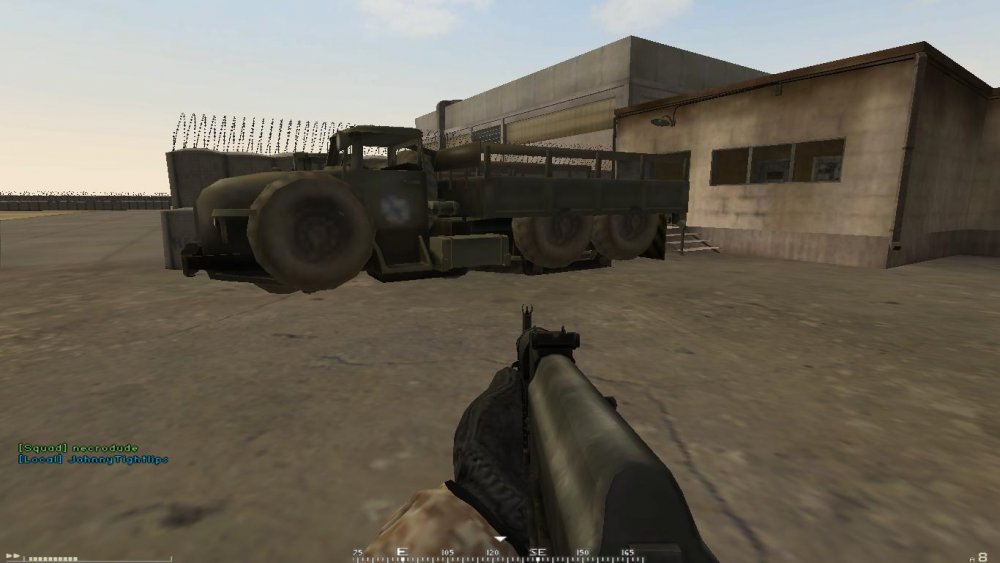
2. Hollow-Man SL ( Kit Geometries not invisible - Vadso City - British Campaign the 2nd)
3. Drunk-Driving Panther CLV with InchPincherToo ( Shijia Valley - British Campaign the 3rd )
4. A way of Militia to chill out in a Logi Truck ( Fools Road - OPFOR Fridays )
Just bought Insurgency in Steam, cool and cheap game, anyone still playing it aside Squad-Based/Tactical FPS games?
- Inch
-
-
 2
2
-
- Report
-
Hey folks, Been a while no see around, really need a suggestions on what should i buy on Steam today.. already had around 6.75 USD in it Plans for me is to buy these beautiful game (at least one/two of them): - Insurgency ( Simple, cheap small game for me, more intense than CS:GO ) - ArmA 2 Combined Operations ( Because the Complete Collection is a bit expensive to me, is it going to be worth if i'm trying to buy it? ) - Red Orchestra 2 HOS / Rising Storm ( Is this a one game or two game? ) It still confuses me till now, all above games ( except RO2/RS ) can be played offlinely and means good to me. And also, does anyone still play these games lately? I see theres a lots of community in these games, very interesting and still alive. Cant wait to see one of these (or maybe more) on my library and play this with you guys if possible. Any suggestions are welcome! Regards, InchPincherToo
-

prbf2 coop insurgency gamemode Gaza Insurgency
=VG= Inch commented on =VG= Fastjack's blog entry in Project Reality Coop Insurgency Gamemode
What an amazing work there, seeing you progressing on making a Coop INS game mode. Loved it-! I'm sure it will be helpful for people who havent readied yet on INS game mode. Btw.. have you discussed about this in PR Forums with the Devs? Might be awesome if this custom mode added to the game -InchPincherToo- 4 comments
-
- 1
-

-
- project reality
- =vg=
-
(and 1 more)
Tagged with:

